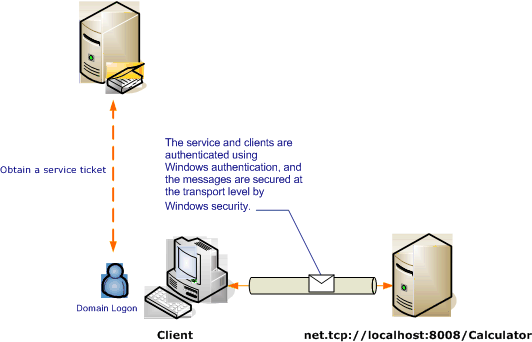Protezione del trasporto con l'autenticazione di Windows
Lo scenario seguente illustra un client e un servizio di Windows Communication Foundation (WCF) protetti dalla sicurezza di Windows. Per altre informazioni sulla programmazione, vedere Procedura: Proteggere un servizio con credenziali di Windows.
Un servizio Web intranet consente di visualizzare informazioni sulle risorse umane. Il client è un'applicazione Windows Form. L'applicazione è distribuita in un dominio in cui la protezione è affidata a un controller Kerberos.

| Caratteristica | Descrizione |
|---|---|
| Modalità di sicurezza | Trasporto |
| Interoperabilità | Solo WCF |
| Autenticazione (server) Autenticazione (client) |
Sì (utilizza l'autenticazione integrata di Windows) Sì (utilizza l'autenticazione integrata di Windows) |
| Integrità | Sì |
| Riservatezza | Sì |
| Trasporto | NET.TCP |
| Binding | NetTcpBinding |
Servizio
Il codice e la configurazione seguenti devono essere eseguiti in modo indipendente. Eseguire una delle operazioni seguenti:
Creare un servizio autonomo usando il codice senza alcuna configurazione.
Creare un servizio usando la configurazione fornita, ma non definire alcun endpoint.
Codice
Nel codice seguente viene illustrato come creare un endpoint del servizio che utilizza la protezione di Windows.
// Create the binding.
NetTcpBinding binding = new NetTcpBinding();
binding.Security.Mode = SecurityMode.Transport;
binding.Security.Transport.ClientCredentialType =
TcpClientCredentialType.Windows;
// Create the URI for the endpoint.
Uri netTcpUri = new Uri("net.tcp://localhost:8008/Calculator");
// Create the service host and add an endpoint.
ServiceHost myServiceHost = new ServiceHost(typeof(Calculator), netTcpUri);
myServiceHost.AddServiceEndpoint(typeof(ServiceModel.ICalculator), binding, "");
// Open the service.
myServiceHost.Open();
Console.WriteLine("Listening...");
Console.ReadLine();
// Close the service.
myServiceHost.Close();
' Create the binding.
Dim binding As New NetTcpBinding()
binding.Security.Mode = SecurityMode.Transport
binding.Security.Transport.ClientCredentialType = TcpClientCredentialType.Windows
' Create the URI for the endpoint.
Dim netTcpUri As New Uri("net.tcp://localhost:8008/Calculator")
' Create the service host and add an endpoint.
Dim myServiceHost As New ServiceHost(GetType(ServiceModel.Calculator), netTcpUri)
myServiceHost.AddServiceEndpoint(GetType(ServiceModel.ICalculator), binding, "")
' Open the service.
myServiceHost.Open()
Console.WriteLine("Listening...")
Console.ReadLine()
' Close the service.
myServiceHost.Close()
Impostazione
Per configurare l'endpoint del servizio, è possibile utilizzare la configurazione seguente anziché il codice.
<?xml version="1.0" encoding="utf-8"?>
<configuration>
<system.serviceModel>
<behaviors />
<services>
<service behaviorConfiguration="" name="ServiceModel.Calculator">
<endpoint address="net.tcp://localhost:8008/Calculator"
binding="netTcpBinding"
bindingConfiguration="WindowsClientOverTcp"
name="WindowsClientOverTcp"
contract="ServiceModel.ICalculator" />
</service>
</services>
<bindings>
<netTcpBinding>
<binding name="WindowsClientOverTcp">
<security mode="Transport">
<transport clientCredentialType="Windows" />
</security>
</binding>
</netTcpBinding>
</bindings>
<client />
</system.serviceModel>
</configuration>
Client
Il codice e la configurazione seguenti devono essere eseguiti in modo indipendente. Eseguire una delle operazioni seguenti:
Creare un client autonomo usando il codice (e il codice client).
Creare un client che non definisce alcun indirizzo di endpoint. Usare invece il costruttore client che accetta il nome della configurazione come argomento. Ad esempio:
CalculatorClient cc = new CalculatorClient("EndpointConfigurationName");Dim cc As New CalculatorClient("EndpointConfigurationName")
Codice
Il codice seguente crea il client. L'associazione è configurata per utilizzare la protezione della modalità trasporto, con il trasporto TCP e il tipo di credenziale client impostato su Windows.
// Create the binding.
NetTcpBinding myBinding = new NetTcpBinding();
myBinding.Security.Mode = SecurityMode.Transport;
myBinding.Security.Transport.ClientCredentialType =
TcpClientCredentialType.Windows;
// Create the endpoint address.
EndpointAddress myEndpointAddress = new
EndpointAddress("net.tcp://localhost:8008/Calculator");
// Create the client. The code for the calculator client
// is not shown here. See the sample applications
// for examples of the calculator code.
CalculatorClient cc =
new CalculatorClient(myBinding, myEndpointAddress);
try
{
cc.Open();
// Begin using the client.
Console.WriteLine(cc.Add(100, 11));
Console.ReadLine();
// Close the client.
cc.Close();
}
' Create the binding.
Dim myBinding As New NetTcpBinding()
myBinding.Security.Mode = SecurityMode.Transport
myBinding.Security.Transport.ClientCredentialType = TcpClientCredentialType.Windows
' Create the endpoint address.
Dim myEndpointAddress As New EndpointAddress("net.tcp://localhost:8008/Calculator")
' Create the client. The code for the calculator client
' is not shown here. See the sample applications
' for examples of the calculator code.
Dim cc As New CalculatorClient(myBinding, myEndpointAddress)
cc.Open()
' Begin using the client.
Try
cc.Open()
Console.WriteLine(cc.Add(100, 11))
Console.ReadLine()
' Close the client.
cc.Close()
Catch tex As TimeoutException
Console.WriteLine(tex.Message)
cc.Abort()
Catch cex As CommunicationException
Console.WriteLine(cex.Message)
cc.Abort()
Finally
Console.WriteLine("Closed the client")
Console.ReadLine()
End Try
Impostazione
Per creare il client, è possibile utilizzare la configurazione seguente anziché il codice.
<?xml version="1.0" encoding="utf-8"?>
<configuration>
<system.serviceModel>
<bindings>
<netTcpBinding>
<binding name="NetTcpBinding_ICalculator" >
<security mode="Transport">
<transport clientCredentialType="Windows" />
</security>
</binding>
</netTcpBinding>
</bindings>
<client>
<endpoint address="net.tcp://localhost:8008/Calculator"
binding="netTcpBinding"
bindingConfiguration="NetTcpBinding_ICalculator"
contract="ICalculator"
name="NetTcpBinding_ICalculator">
</endpoint>
</client>
</system.serviceModel>
</configuration>